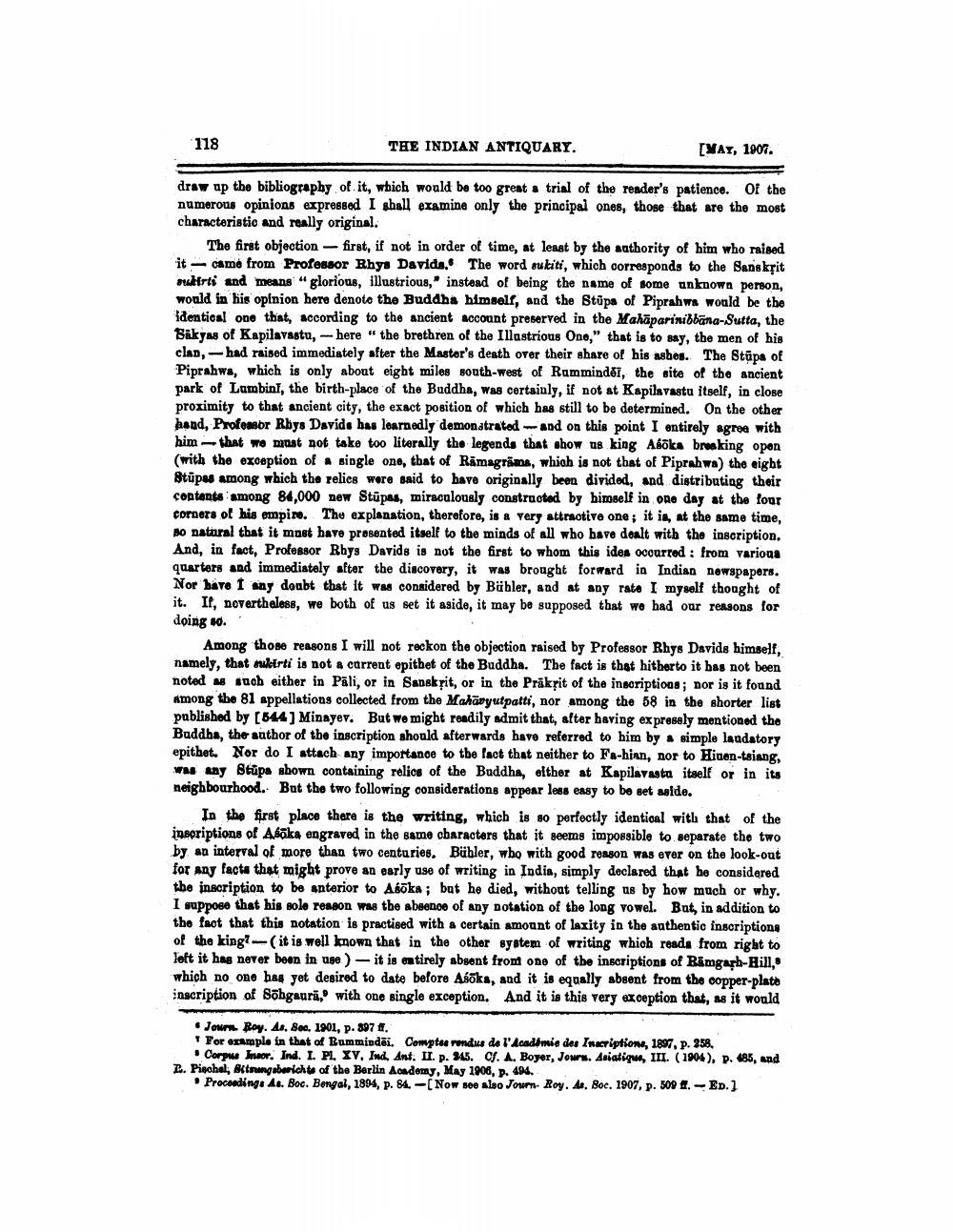________________
118
THE INDIAN ANTIQUARY.
(YAY, 1907.
draw ap the bibliography of it, which would be too great a trial of the reader's patience. Of the numerous opinions expressed I shall examine only the principal ones, those that are the most characteristic and really original.
The first objection - first, if not in order of time, at least by the authority of him who raised it - came from Professor Rhys Davids. The word sukiti, which corresponds to the Sansksit wirts and means "glorious, illustrious, instead of being the name of some unknown person, would in his opinion here denoto the Buddha himself, and the Stups of Piprahws would be the identical one that, according to the ancient account preserved in the Mahāparinibbana-Sutta, the Bakyas of Kapilavastu, - here " the brethren of the Illustrious Ono," that is to say, the men of his clan, -had raised immediately after the Master's death over their share of his ashes. The Stāpa of Piprahwa, which is only about eight miles south-west of Rammindēi, the site of the ancient park of Lambini, the birth-place of the Buddha, was certainly, if not at Kapilavastu itself, in close proximity to that ancient city, the exact position of which has still to be determined. On the other hand, Professor Rhys Davids has learnedly demonstrated and on this point I entirely agree with him that we must not take too literally the legends that show us king Aboka breaking opon (with the exception of single one, that of Rāmagrams, which is not that of Piprahwa) the eight 8tūpus among which the relies were said to have originally been divided, and distributing their contents among 84,000 new Stūpas, miraculously constructed by himself in one day at the four corners of his empire. The explanation, therefore, is a very attractive one; it is, at the same time, BO natural that it must have presented itself to the minds of all who have dealt with the inscription. And, in fact, Professor Rhys Davids is not the first to whom this ides ocourred: from varioga quarters and immediately after the discovery, it was brought forward in Indian newspapers. Nor have I any doubt that it was considered by Bühler, and at any rato I myself thought of it. IP, nevertheless, we both of us set it aside, it may be supposed that we had our reasons for doing so.
Among those reasons I will not reckon the objection raised by Professor Rhys Davids himself, namely, that nukirti is not a corrent epithet of the Buddha. The fact is that hitherto it bas not been noted as such either in Pāli, or in Sanskrit, or in the Pråkpit of the inscriptions; nor is it found Among the 81 appellations collected from the Mahāryutpatti, nor among the 58 in the shorter list published by [644 ) Minayev. But we might readily admit that, after having expressly mentioned the Buddha, the author of the inscription should afterwards have referred to him by a simple laudatory epithet. Nor do I attach any importance to the fact that neither to Fa-hian, nor to Hinen-tsiang, WAS kay Stüpa shown containing relics of the Buddha, efther at Kapilavasta itself or in its neighbourhood. But the two following considerations appear less easy to be set aside.
In the first place there is the writing, which is so perfectly identical with that of the inspriptions of Acôka engraved in the same characters that it seems impossible to separate the two by an interval of more than two centuries. Bähler, who with good reason was ever on the look-out for any facts that might prove an early use of writing in India, simply declared that he considered the inscription to be anterior to Asöka ; but he died, without telling us by how much or why. I suppose that his sole reason was the absence of any notation of the long vowel. But, in addition to the fact that this notation is practised with a certain amount of laxity in the authentic inscriptions of the kingi-(it is well known that in the other system of writing which reads from right to left it has never been in use) - it is entirely absent from one of the inscriptions of Bāmgarh-Hill, which no one has yet desired to date before Asoka, and it is equally absent from the copper-plato inscription of sõbgaura, with one single exception. And it is this very exception that, as it would
• Jorunn Roy. As, Sec. 1901, p. 897 ff.
For example in that of Bummindai. Comptes rendus de l'Académie des Inscription, 1897, p. 258
Corpu Iner. Ind. L. PL. XV, Inc. Ant. II. p. 345. Cf. A. Boyer, Jours. Asiatique, III. (1904), p. 485, and L. Pinchal, Strungaberichte of the Berlin Academy, May 1906, p. 494.
• Proceedinge A. Boc. Bengal, 1894, p. 84. - (Now see slao Journ Roy. Ar. Soc. 1907, p. 509 4.-ED.)




